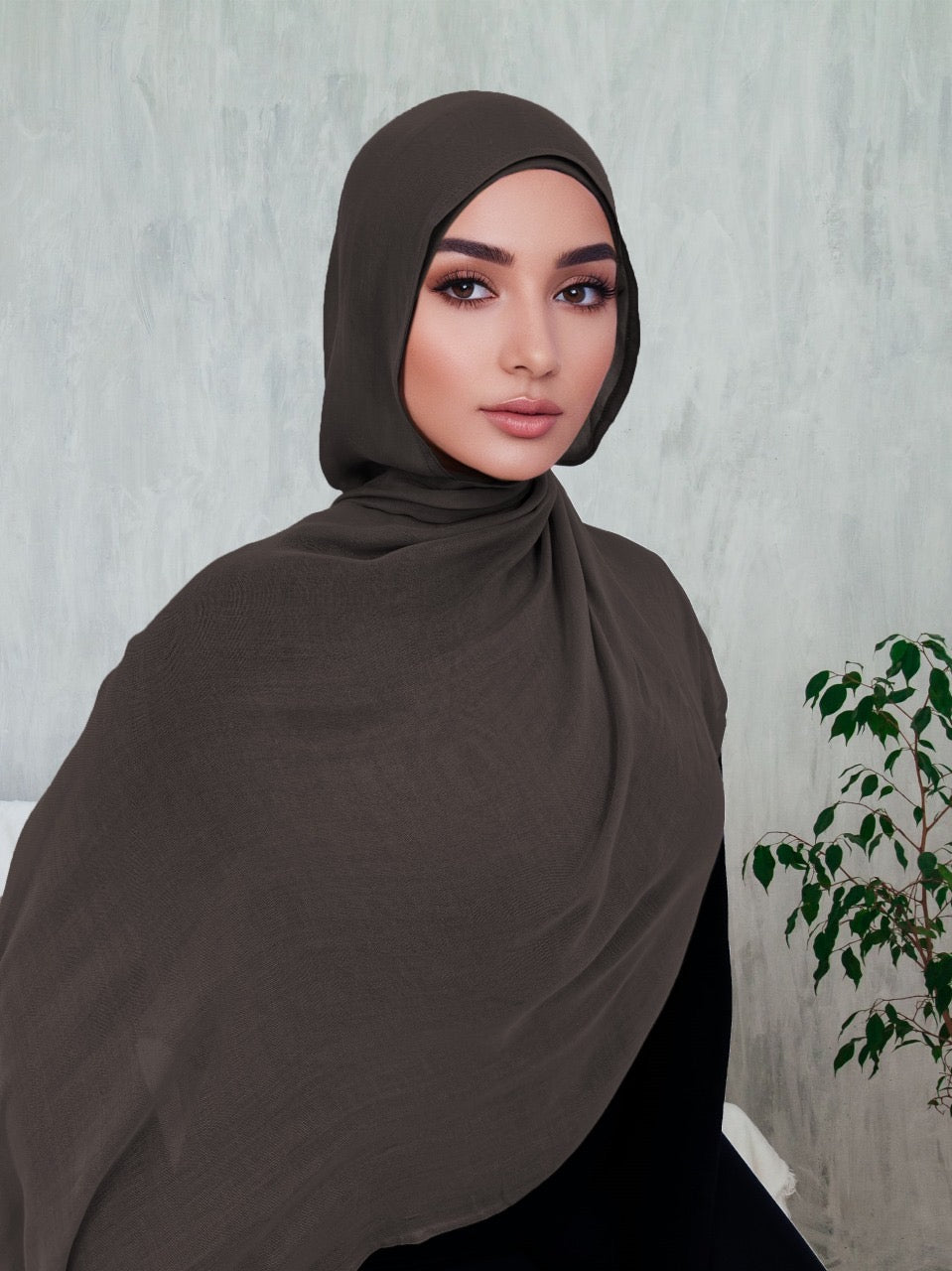When it comes to comfort and style, choosing the right fabric is crucial. The fabric you wear directly affects how comfortable you feel throughout the day and how confident you look. Among the many options available, two fabrics stand out for their popularity and versatility: jersey and modal. Each of these fabrics has unique properties that make them suitable for different occasions, climates, and personal preferences.
In this guide, we’ll take a deep dive into both fabrics, comparing their features, benefits, and ideal uses. By the end, you'll know exactly when to choose jersey over modal, and vice versa, to maximize comfort, performance, and style.
What Is Jersey Fabric?
Jersey fabric is a type of knit fabric that is celebrated for its incredible stretch and comfort. Whether you're lounging at home or heading out for a casual day, jersey has likely been one of your go-to fabrics. But what makes jersey stand out? Let’s break it down.
Definition:
Jersey is a stretchy fabric that has a smooth surface on one side and a slight texture on the other. It's primarily knitted, which gives it the ability to stretch in multiple directions.
Composition:
Traditionally, jersey is made from cotton, but it can also be made from polyester or blends of these fibers with elastane (spandex). The inclusion of elastane adds a bit of extra stretch, allowing jersey to maintain its shape after use.
Types of Jersey:
-
Single Jersey: This is a lightweight, stretchy, and breathable version of the fabric, commonly used in everyday clothing like T-shirts and dresses.
-
Double Jersey: This type is thicker, more stable, and less prone to curling at the edges. It is often used for more structured garments.
-
Interlock Jersey: Unlike regular jersey, interlock jersey is smooth on both sides and has a slightly more structured feel. It’s used in things like more formal dresses or thicker tops.
Common Uses:
-
T-shirts
-
Dresses
-
Activewear
-
Loungewear
Jersey fabric is particularly famous for its flexibility and comfort, making it a favorite for casual wear and basic garments.
What Is Modal Fabric?
While jersey is beloved for its stretch and durability, modal fabric is often praised for its luxurious feel and eco-friendly nature. Made from the pulp of beech trees, modal is a semi-synthetic fiber with a smooth, silky texture. Let’s take a closer look at what makes modal stand out.
Definition:
Modal is a type of rayon, which is a semi-synthetic fiber derived from natural plant materials. In this case, beech tree pulp is processed into fibers that are then spun into fabric.
Properties:
-
Silk-Like Softness: Modal fabric has a smooth and luxurious feel, often described as similar to silk but more affordable.
-
Breathability: One of the standout features of modal is its exceptional breathability. It’s highly moisture-wicking and can help keep you dry, making it ideal for warmer climates.
-
Eco-Friendly: The production of modal is considered to be more environmentally friendly compared to many other synthetic fibers. Beech trees grow quickly, and the production process uses less water than cotton.
Common Uses:
-
Underwear
-
Pajamas
-
Bed sheets
-
Activewear
Modal’s silky softness and breathable nature make it ideal for garments that come into direct contact with your skin, offering a comfortable, luxurious feel.
⚖️ Jersey vs. Modal – A Comparative Analysis
Now that we know what both fabrics are, let’s compare them head-to-head across key factors to help you decide which one is better for your needs.
|
Feature |
Jersey |
Modal |
|
Softness |
Soft, but less than modal. |
Silk-like softness. |
|
Breathability |
Good, especially in cotton blends. |
Excellent, ideal for hot climates. |
|
Moisture-Wicking |
Moderate. |
High, keeps you dry. |
|
Durability |
Resistant to pilling and stretching. |
Prone to pilling if not cared for. |
|
Eco-Friendliness |
Varies by blend. |
More sustainable production. |
|
Price Range |
Affordable. |
Moderately priced. |
Softness:
While both fabrics are soft, modal takes the lead with its luxurious, silk-like texture. If you’re looking for the ultimate softness, especially for garments that touch your skin, modal is the way to go.
Breathability:
Both fabrics are breathable, but modal’s breathability is superior. Its ability to wick away moisture and keep you dry makes it ideal for hot weather and activewear. Jersey, on the other hand, performs well in cotton blends but can be less breathable when made with synthetic fibers.
Moisture-Wicking:
Modal excels in moisture management. Whether you're working out or simply living in a humid environment, modal will keep you dry and comfortable. Jersey’s moisture-wicking properties are moderate but not as effective as modal.
Durability:
Jersey is quite durable and resistant to pilling and stretching, especially in cotton blends. Modal, while soft and breathable, can be more prone to pilling if not cared for properly.
Eco-Friendliness:
Modal’s production process is more eco-friendly compared to most synthetics. Beech trees require less water than cotton and can be sustainably harvested. Jersey's eco-friendliness depends largely on the blend, particularly if it's made from organic cotton or recycled materials.
Price Range:
Jersey is generally more affordable than modal, making it an excellent choice for budget-conscious shoppers. Modal, while still reasonably priced, tends to cost a bit more due to its luxurious feel and eco-friendly properties.
When to Choose Jersey
While modal is luxurious and eco-friendly, jersey has its own set of benefits that make it the go-to fabric for many casual and everyday garments.
Everyday Comfort:
Jersey is the fabric of choice for everyday wear. Its softness, stretch, and breathability make it perfect for T-shirts, loungewear, and casual dresses.
Budget-Friendly:
If you're on a budget, jersey is a great option. It’s much more affordable than modal, making it suitable for buying in bulk or creating a wardrobe full of comfortable basics.
Durability:
Jersey is highly durable when properly cared for. It resists pilling and stretching, making it an excellent option for long-lasting, everyday pieces.
Versatility:
Jersey is incredibly versatile. You can find it in many different forms and weights, from lightweight T-shirts to thicker, more stable varieties used in dresses and activewear.
When to Choose Modal
Modal is not just for luxury; it’s a practical choice in certain situations too. If you want something that feels soft against your skin or are looking for a breathable fabric for warmer climates, modal is an excellent option.
Luxurious Feel:
For items that touch your skin, such as underwear, sleepwear, and pajamas, modal’s silky softness makes it an ideal choice.
Breathability:
If you live in a hot climate or want a fabric that keeps you cool during physical activities, modal’s breathability and moisture-wicking properties make it the superior choice.
Eco-Conscious Choice:
Modal is a more sustainable option compared to other fabrics, especially when sourced from eco-friendly producers. If you prioritize sustainability, modal is a great choice.
Moisture Management:
Modal excels in moisture-wicking, making it a great option for activewear. It helps keep you dry and comfortable, even during the most strenuous activities.
Care Tips for Both Fabrics
Proper care can significantly extend the life of both jersey and modal fabrics.
Jersey Care:
-
Machine wash in cold water to prevent shrinking.
-
Tumble dry on low or air dry.
-
Avoid using bleach to maintain color.
Modal Care:
-
Hand wash or machine wash on a gentle cycle.
-
Air dry to prevent shrinkage.
-
Iron on low heat if necessary.
Making the Right Choice
Both jersey and modal have their own unique advantages.
-
Choose Jersey: If you’re looking for comfort, durability, and affordability for casual wear, jersey is your fabric of choice. It’s versatile, easy to care for, and great for everyday use.
-
Choose Modal: If you prefer a luxurious feel, excellent breathability, and eco-friendliness, modal is the perfect option. It’s ideal for items that touch your skin and is perfect for warmer climates.
Ultimately, your decision should be based on your personal preferences, climate, and budget. With the right fabric, you can enjoy maximum comfort and style.
Ready to experience the difference yourself? Explore our premium collection of Jersey and Modal hijabs here.
FAQs
Is modal fabric suitable for sensitive skin?
Yes, modal’s smooth texture is gentle on the skin, making it ideal for sensitive skin types.
Can jersey fabric shrink after washing?
Yes, especially if not washed according to care instructions. It’s best to wash in cold water and air dry.
Which fabric is better for hot weather?
Modal is more breathable and moisture-wicking, making it ideal for hot climates.
Is modal fabric eco-friendly?
Yes, modal is considered more sustainable, especially when sourced from environmentally conscio us producers.
Can I blend jersey and modal fabrics?
Yes, blending the two fabrics can combine the benefits of both, offering stretch, softness, and breathability


